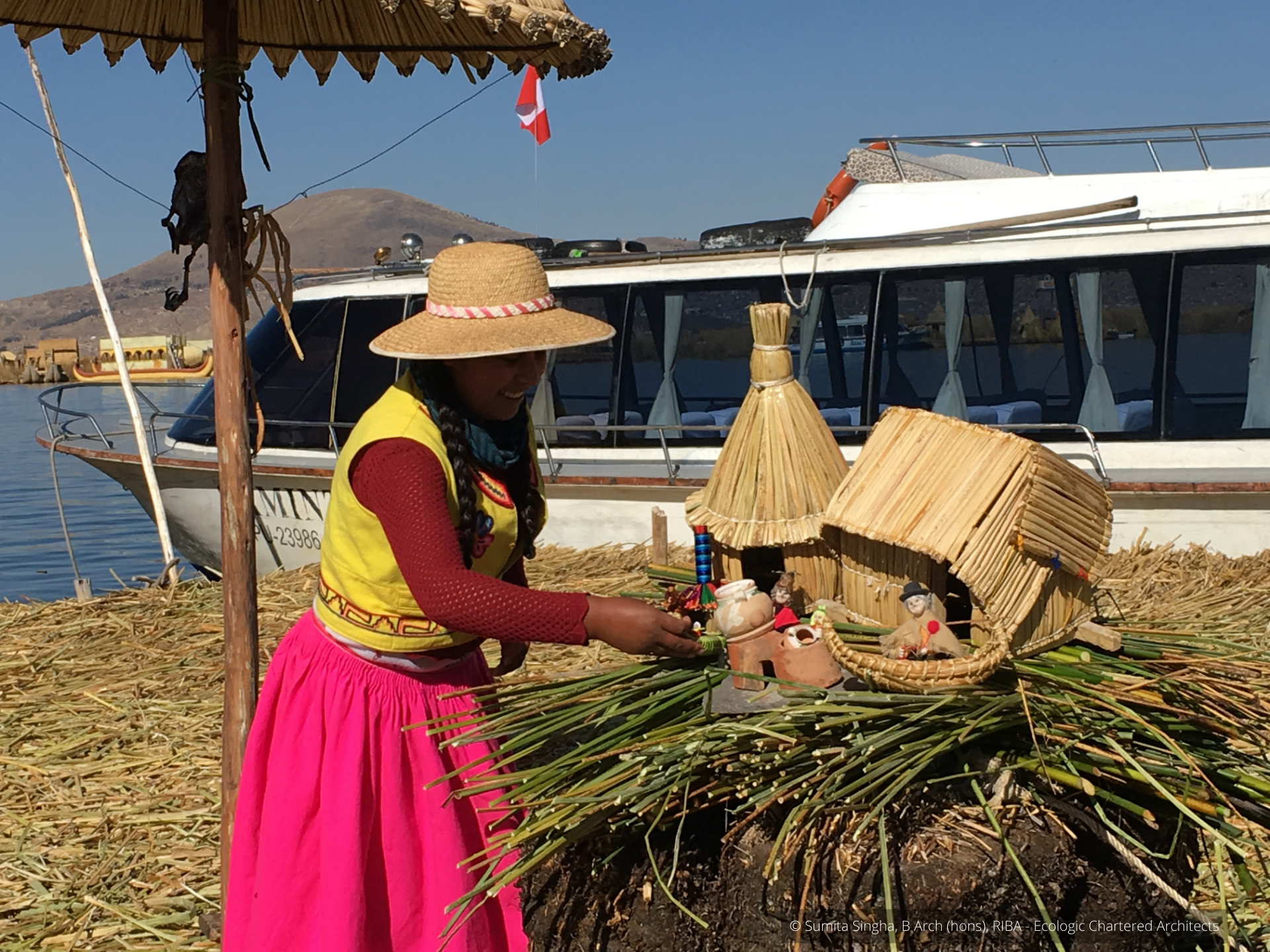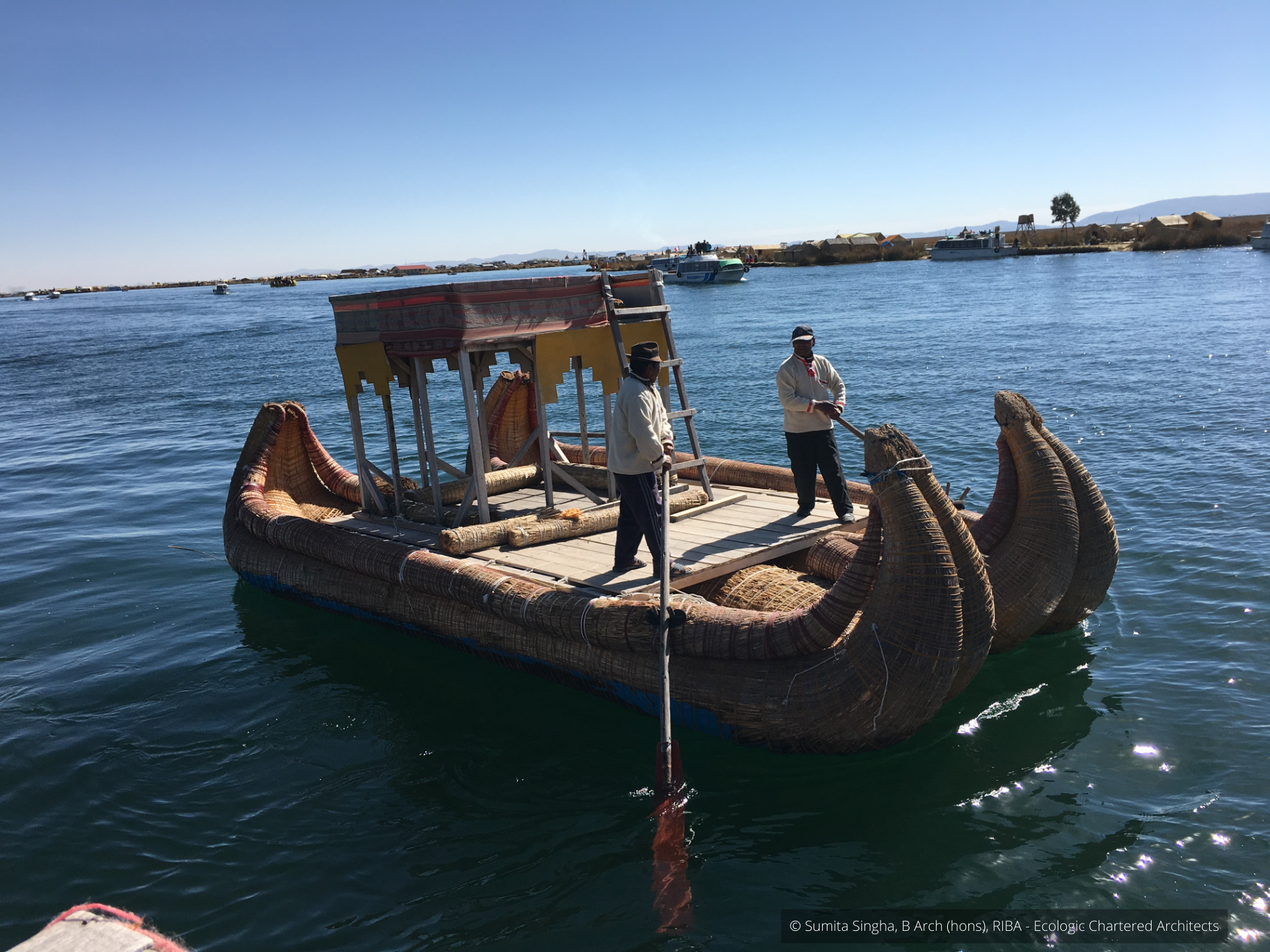The floating islands of Lake Titicaca, Peru/Bolivia: Guest post by Sumita Singha, B Arch (hons), RIBA
On Titicaca, a high-altitude fresh water lake which lies between Peru and Bolivia, are to be found ‘floating islands’ made of locally available reeds, Totora (a subspecies of the giant bulrush sedge). These reeds usually grow at a water depth of 2.5–3 m (8.2–9.8 ft) but could also grow as deep as 5.5 m (18 ft). As the water gets deeper the roots no longer reach the bottom, so they use the oxygen in their root mass for buoyancy, and the surrounding vegetation for support. These reeds are dried and used for making boats, homes and the islands themselves by the Uru (or Uros), who are an indigenous people of Peru and Bolivia. Thus these islands are a form of sustainable and renewable form of land reclamation. Most of the islands on Lake Titicaca were near the middle of the lake, about 9 miles from the shore but after a major storm in 1986, these islands were rebuilt closer to the mainland for safety.
The bottom layer of these islands is made of earth and a large mass of interwoven totora roots. This sacrificial layer about 4x10 metres of root mass and earth is 1-2m deep and is called Khili. The Khili blocks are attached to ropes tied to large Eucalyptus or steel poles driven into the bottom of the lake to anchor them. Once the blocks are tied and anchored, layers of reeds are added to the top surface. As the bottom layer of covering reeds rot away, new reeds are added on top about every two weeks to three months depending on the season. The top also weathers away due to walking on and needs constant maintenance.
These floating islands reportedly last as long as 30 years which is very good considering that the normal lifespan of modern materials are about 60 years. The islands can only take small static loads, like the simple reed huts which are built upon an additional 1m reed layer to prevent moisture build-up inside the hut. The larger islands can be inhabited by the homes of ten families, while smaller ones, can house two or three families. Some larger islands have small ‘ponds’ lined with fishing nets in which fish are kept for human consumption. The totora reeds are also eaten by humans and animals, used for medicines and tea, the dried reeds are burnt as firewood. Most islands have PV panels for modern appliances such as televisions and radios. Toilets are to be found on 'outhouse' islands near the main islands with simple toilets installed in them. There are primary schools on several islands. The main source of income for Uru people is from tourism and many have now moved to the mainland while retaining their huts for tourism. Each island rotates their tourism services on a daily basis.


Sumita Singha, B Arch (hons), RIBA
About the author:
Sumita Singha is a chartered architect based in London with her own practice, Ecologic. She received the UIA: UNESCO International Design Award amongst others. Sumita has taught architecture in the UK and abroad, including Cambridge. She has written several books on architecture, looking at it from environmental, social, economic and political angles: Architecture of Rapid Change and Scarce Resources (Routledge 2012), Autotelic Architect (Routledge, 2016), Women in Architecture: Critical Concepts (Routledge 2017), Future Healthcare Design (2020) and also contributed to many other publications. She has worked as an artist and photographer with exhibitions and publications to her name.
Sumita was the Chair of Women in Architecture and the founder of the first equality forum, Architects For Change, at the Royal Institute of British Architects. These forums have helped to raise the profile and numbers of female architects in a male-dominated construction industry. Sumita was awarded the Inspirational Leader Award, The Ford Diversity Award and Women Into Business awards. She sits on the RIBA professional standards committee and was elected to the RIBA Council 2011-14 and has been a member of several RIBA committees, including education, ethics and professional practice.
In addition, she set up an environmental charity, Charushila, which has carried out community projects in many parts of the world including the UK, Venezuela, India and Palestine. Sumita is a trustee of Architects Benevolent Society and Commonwealth Association of Architects.
Sumita is also a non-Executive Director of Moorfields Eye Hospital NHS Foundation Trust, where she chairs the ‘People and Culture’ Committee, and a member of NHS England’s sustainable health system leadership group. She is the co-founder of the Seacole Group, which promotes BAME leadership and mentoring in the NHS.
